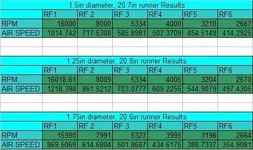I've heard of this effect before, but never to the extent of 7psi. I've heard of great N/A tuners hitting 3-4psi, however I've never seen it with my own eyes.
Agreed. I started researching this back in Feb or March, and am actually still waiting on billet IM flanges from the machine shop (can you say expensive?).
A lot of our stock parts aren't bad, but yeah, the intake mani is the biggest weak link I can find. The only thing I'm not sure about is that if I do end up coming out with an IM (as planned), it will be costly to make (although the gains will be nice). I'm not sure how much interest there would be in it due to cost.
Mines going to be a one off. To do it properly the ram tunnel and plennum(the helmholtz part) NEEDS to be tuned to the motor. Its very dependent on VE, target RPM and so forth. On a turbo car, from what i can tell, the manifold is going to give gains through improved flow - because no matter how strong your pressure waves are from the tuned runners (which are the same regardless, and only the target RPM is a concern, because the speed of sound is whats used, not VE and so forth), pressure from the turbo is going to bury them.
Should be able to make a "max flow" beefy turbo intake manifold with very little effort or expense.
But an NA intake manifold, like most things NA, is going to need to be highly adaptable to different circumstances. An NA motor is a finely tuned beast - get something wrong and it wont achieve what you want it to achieve.
I'd be willing to share with you my 3D design for the manifold if it helps you bring something into production. Just got to find some time to get my manifold off and work out how much space i've got to work with.
4psi is easy - you can get that with a properly designed ram scoop (and a ghetto ram scoop will consistantly sit you at 2psi at high speed) - utilizing the reflections to boost the pressure is a whole different beast - you are unlikely to be able to see "7psi" on a boost gauge with it because the pressure build up occurs at the valve, and would be substantially weakened in the plennum where you are drawing your vac sources. The 7psi figure i've been quoted is apparently extrapolated from fueling requirements, not from an actual reading - but we shall wait and see. Also worthwhile noting that the 7psi figure is based on the 1st reflection, the single biggest kick you are going to get - and that means spastically long runners (the pressure wave which starts at a closed valve needs enough runner length to travel all the way back to the opening of the runner, and then back down in time to catch an open valve - 2nd reflection is much easier, half the runner length, the pressure wave bounces back twice, but you lose some of the strength).
I'm looking forward to being the first NA guy to bend a rod for reasons other than oil starvation or insane RPM. I'm also going to run a meth kit on it i think, for some saftey until the engine is built. Means i can't run it in my favorite "all motor" class because the rules define a power adder as anything device which boosts intake pressure, or adds any chemical to the fuel system after the fuel tank outlet. But at least I wont kill my motor before I can afford to rebuild it.....
I think there are plenty of weak links in the motor. Rods, stock exhaust manifold, stock intake manifold, stock intake system, stock head, lack of wall thickness in the cylinders limiting overbore (hence why i'm sleeving when i rebuild), poor rod ratio (not such a big deal for you turbo guys, but its a real pain in the butt for extreme NA buildups) - i could go on.. Needless to say, I intend to dress all of these issues in my build

edit: you mind giving me your flow bench figures on the stock manifold? would be interesting to see what I can come up with on my custom job when its done - give me something to compare to.... also how does the stock intake manifold flow in relation to the stock head? is it a notable restriction or are they pretty well matched to one and other?

